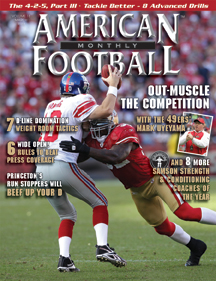Article CategoriesAFM Magazine
|
Run Stoppers – Improve your defense with Princeton’s schemes, adjustments, and drills.by: Jared BackusDefensive Coordinator, Princeton University © More from this issue Your defensive structure must be simple, it must allow your players to play fast, and it must be adjustable to multiple schemes and sets that offenses present. Our base fronts and coverages are based on the personnel that we have in our program at the present time. Therefore, what works with one group, one year, might not with the next year’s group. We are constantly assessing and reinventing to get better as a defense. With that said, we have installed and implemented a foundation of core values – effort, tackling and ball disruption – that doesn’t change year to year. These values are critical to our success. It was our decision to play more odd fronts in 2011 on first and second downs based on the personnel that we had. In 2010, our defense was among the nation’s worst at defending the run. We realized that “you get what y....The full article can only be seen by subscribers.
|
|
|||||||
| HOME |
MAGAZINE |
SUBSCRIBE | ONLINE COLUMNISTS | COACHING VIDEOS |
Copyright 2025, AmericanFootballMonthly.com
All Rights Reserved





